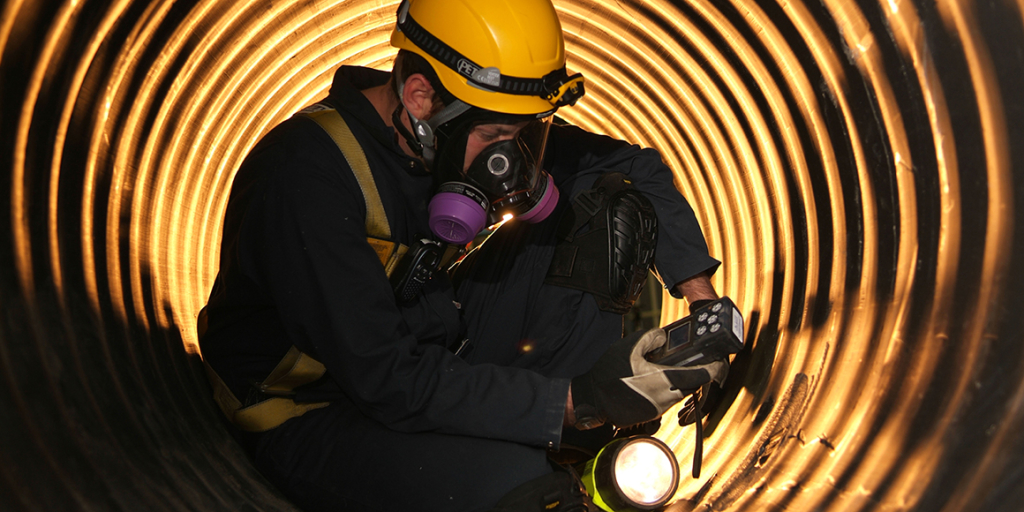
Working in Confined Spaces: Health and Safety Regulations
Everything you need to know about confined spaces in Ontario comes from Ontario Regulation 632/05. You can download it here for future reference, or contact us ACUTE to learn more.
Confined spaces defined
You will find that “confined space” is defined as a fully or partially enclosed space,
(a) that is neither designed nor constructed for continuous human occupancy, and
(b) in which atmospheric hazards may occur because of its construction, location, contents, or because of work that is done in it.
The Canadian Centre for Occupational Health and Safety adds confined spaces can “represent a risk for the health and safety of anyone who enters, due to one or more of the following factors:
- its design, construction, location or atmosphere
- the materials or substances in it
- work activities being carried out in it, or the
- mechanical, process and safety hazards present.”
Confined spaces are, therefore, considered high-risk work areas, and workers and would-be rescuers have been killed on the job in the past.

Examples of spaces that are not designed and constructed for continuous human occupancy include tanks, vessels, silos, storage bins, vaults, pits, manholes, tunnels, ductwork, and pipelines.
What you need to do to prepare for work in confined spaces
Each time you plan to enter any workspace, you should determine if that workspace is considered a confined space.
According to CCOHS, your program should include the following, in accordance with Reg. 632/05:
- “Description of roles and responsibilities of each person or party (e.g., employer, supervisor, workers, attendants, and emergency response team).
- Advice on how to identify confined spaces.
- The identification and assessment of all potential hazards that may exist at the beginning of the work, as well as those that may develop because of the work activities.
- A plan to eliminate or control all identified hazards.
- Written work procedures.
- Training program for all the workers that will enter into the confined spaces.
- The establishment of an entry permit system for each entry into a confined space.
- Development of an emergency plan complete with training and equipment in case an unforeseen situation occurs.
- An emergency response system.
- Reporting and investigating incidents related to work in confined spaces.
- Record and documentation control.
- Program review whenever there is a change in circumstances or at least annually, to identify program weaknesses and make any necessary changes to the program.”
The entry permit is an administrative tool you will use to document the completion of a hazard assessment for each confined space entry.

Someone fully trained and experienced in confined space work should complete the entry permit.
What you will learn in confined space training
Confined space entry training begins by familiarizing you with Regulation 632/05 . This educational aspect of the course is intended to provide you with the knowledge required to recognize confined space entry risks, and how to respond in the event of any issues that arise.
Later, you will have the opportunity to become familiar with, inspect, and use Confined Space Entry (CSE) access equipment and air quality instrumentation.
To achieve that balance of classroom learning and in-the-field, practical training, your confined space entry training should be conducted at an appropriate safety training center that offers the following:
- Industry standard health and safety equipment and technologies
- Simulation areas for a full suite of training programs (i.e. working at heights, confined spaces, and hazardous materials)
- Classroom facilities for lecture and technical training delivery
- Human dummies for confined space rescue and hazardous material controls.
That’s exactly what ACUTE’s training course offers – check our calendar to pick a date that works best for you. Be sure to set aside a full day for the course!
Additionally, confined space rescue builds on the content of the initial course to train you more on the safety considerations and how to safely perform a rescue from confined space.

Be sure to set aside a full day for confined spaces entry training.
Trust ACUTE for Confined Spaces Training!
Hands-on, practical confined spaces training is the best way to keep employers and workers safe in the workplace!
ACUTE is dedicated to workplace safety and understands the importance of course and training provider approval.
Why get workplace safety training with ACUTE? Here are just some of the benefits of working with us:

- Open Door Instructor-Student Partnership – ACUTE’s training services emphasize client participation. Staff foster relationships with clients and serve as a touchstone for advice anytime moving forward.
- Serving Your Team and Industry – With a vast array of clients in manufacturing, construction, health, academic, and government sectors, ACUTE brings the best safety practices from across the spectrum to your workplace.
- 100 Years Combined Experience – ACUTE provides comprehensive health and safety training, on-site safety services, and consulting services. With over 100 years of combined experience, our company staff offer more than theoretical or abstract ideas. ACUTE offers solutions.
- Track Record of Success – ACUTE is rated 4.9/5 stars on Google reviews, demonstrating a commitment to our clients, quality, and passion for training.
What people are saying about ACUTE:
“ACUTE Environmental & Safety Services has been provided OABA members in the agri business sector with excellent training services since January, 2018. OABA recommends ACUTE as a quality health and safety training provider.” – Dave Buttenham
ACUTE is located in Waterloo, Ontario, and services customers from cities such as Toronto, Mississauga, Brampton, Hamilton, Milton, Kitchener, London, Guelph, and others across Ontario.
Trust ACUTE for your confined space entry training needs.


